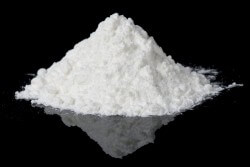 The manufacture and trafficking of illegal and illicit drugs is big business. According to a report published by Frontline® on PBS, the global drug industry produces hundreds of billions – that’s with a “b”— of dollars each year, with the United States leading the way. Those individuals who supply the drugs to the end user are not doing so because they want people to feel good. They supply these drugs in order to make a profit, and each producer, distributor and dealer on the street needs to increase their profit margin in order to see more financial benefits for their work. The same may be true for any profitable business, of course, but a markup on cocaine can be more deadly than a car dealer who overcharges for weatherproofing. Drug dealers and traffickers do this by adding dangerous chemicals that look like, or have other characteristics of cocaine, in order to make their initial investment last longer.
The manufacture and trafficking of illegal and illicit drugs is big business. According to a report published by Frontline® on PBS, the global drug industry produces hundreds of billions – that’s with a “b”— of dollars each year, with the United States leading the way. Those individuals who supply the drugs to the end user are not doing so because they want people to feel good. They supply these drugs in order to make a profit, and each producer, distributor and dealer on the street needs to increase their profit margin in order to see more financial benefits for their work. The same may be true for any profitable business, of course, but a markup on cocaine can be more deadly than a car dealer who overcharges for weatherproofing. Drug dealers and traffickers do this by adding dangerous chemicals that look like, or have other characteristics of cocaine, in order to make their initial investment last longer.
For instance, if a drug trafficker purchases several thousands of dollars worth of cocaine from the manufacturing cartels in South America, he will increase the content with filler chemicals. One kilogram of cocaine may then become 2 kilograms, or 1.5 kilograms, depending upon how many types of filler are added.
The First Stop in the Adulteration of Cocaine: The Manufacturer
Cocaine is manufactured in the jungles of South America, as highlighted in a report published in The Sun, a newspaper in Great Britain. It begins its life as a natural chemical created inside the coca plant. According to this report, the process involved in making cocaine paste, the substance from which powder cocaine is created, is both dangerous and unsavory. For instance, both hydrochloric acid and kerosene are part of the recipe. These substances are not used to cut the cocaine; however, the end result is a solid brick that is approximately 50 percent cocaine, according to the Drug Enforcement Agency Museum.
Extending Profit Using Poison and Pharmaceuticals
Some of the ingredients added to cocaine have been chosen because of their anesthetic quality. Cocaine has a numbing effect on the surface of the skin, according to a report by the BBC. One of the cutting agents used to adulterate, or stretch, cocaine for profit is benzocaine, which is an ingredient in suntan lotion and first aid ointments. The Food and Drug Administration has warned that the anesthetic sprays containing benzocaine can cause a condition known as methemoglobinemia. This condition can cause:
- Loss of oxygen to the blood casing cyanosis
- Confusion
- Coma
- Irregular heartbeat and hypotension (hemodynamic instability)
Another cutter found in cocaine is boric acid. Boric acid is also found in insecticides. While it is found in some medicinal, cosmetic and antiseptic products, these products are not for internal use. Boric acid resembles cocaine and can therefore be added in unregulated quantities to increase the volume for resale.
Perhaps one of the most blatantly disturbing ingredients in the cocaine that is purchased by end users at the street level is dimethylterephthalate. This is a chemical used in the manufacture of plastic. Another very disturbing ingredient found in cocaine is the poison, strychnine. According to the Centers for Disease Control, this poison is most commonly found in rat poison, but it has been found in heroin, cocaine and LSD.
Getting Help for Cocaine Addiction
Cocaine, because of the short length of the euphoric effects, which can last for as little as a half-hour in some cases, is a highly addictive drug. The drug user will binge repeatedly in order to maintain the high, thereby increasing the rate of tolerance and addiction. The more an individual uses cocaine, the more frequently they are introducing the cutting agents used to make the substance profitable for the drug dealers. The cycle goes on until the drug user finally finds the strength and support to get the help they need. Sometimes, it is necessary to point out just how damaging drug abuse and addiction has become to a person’s life.
Detoxing from cocaine addiction is not a cure or even a treatment for the disease of addiction, according to the experts at the National Institute on Drug Abuse. Once the drug abuser has stopped using the drug and made it through the immediate withdrawal period, they will have much better results if they enroll in an effective treatment program, like that offered here at Axis. Each individual comes to us with a unique story and life events that have led them to this healing time in their lives. We can tailor a treatment program to meet the specific needs of you or a member of your family, and create an environment of hope for a brighter future. Call now.


